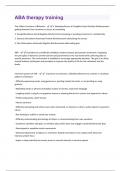ABA therapy training
The 4 Main Functions of Behavior - 1. Attention/Access to Tangibles-Social Positive Reinforcement-
getting attention from someone or access to something
2. Escape/Avoidance-Social Negative Reinforcement-escaping or avoiding someone or a task/activity
3. Sensory Stimulation-Automatic Positive Reinforcement-stimulating the senses
4. Pain Attenuation-Automatic Negative Reinforcement-attenuating pain
ABA - Considered a scientifically validated, evidence-based, best practice treatment of applying
the principles of behaviors (reinforcement and punishment) in the real world while collecting data on
specific behaviors. The environment is modified to encourage appropriate behavior. The goal is to utilize
several behavior techniques and principles to improve the quality of life for the individuals and the
family
Common systems of ASD - · Insistence on sameness, inflexible adherence to routines or ritualized
patterns of behavior
· Difficulty expressing needs, using gestures or pointing instead of words, or not pointing or using
gestures
· Repeating words or phrases (echolalia) in place of normal, responsive language
· Laughing and/or crying for no apparent reason or showing distress for reasons not apparent to others
· Prefers being alone, aloof manner
· Intense tantrums
· Difficulty interacting with others even when interested, no interest in others, and/or doesn't respond to
others
· Not wanting to cuddle or avoids eye contact
· Difficulty understanding the feelings of others or communicating their own emotions
· Sustained, repetitive odd play, no imitative play, and/or does not engage in pretend/interactive play
· Stereotyped or repetitive motor movements
· Obsessed attachment to objects or restrictive, fixated interested on one subject with abnormal
intensity and/or focus
· Hyper or hypo reactivity to sensory input or unusual interests in sensory aspects
,· No real fears or danger
· Noticeable physical over activity extreme under activity
· Uneven patterns of development
· Unresponsive to verbal cues or acts as if deaf, but responds to other sounds
Possible causes of ASD - · Abnormalities in brain structure or function
· Heredity, genetics, or medical problems
· Childhood vaccinations and food allergies
· Other biological and environmental factors
Prevalence of ASD - · Insistence on sameness, inflexible adherence to routines or ritualized
patterns of behavior
· The CDC reports 1 in 59 U.S. children have been identified with ASD
· Over 3.5 million U.S. children and adults are believed to have some form of ASD
· Rate is growing more than 10-17% per year
· 5 times more likely in boys than girls (1 in 42 boys, 1 in 189 girls)
· Occurs in all racial, ethnic, and socioeconomic groups
· Parents who have a child with ASD have a 2-18% chance of having a second child who is also affected
· Almost have (46%) of children identified with ASD have average to above average intellectual
disabilities
· The co-occurrence of one or more non-ASD developmental diagnoses (other developmental,
psychiatric, neurological, chromosomal, and genetic diagnoses) is 83%
· Research has shown that a diagnosis of ASD at age 2 can be reliable, valid, and stable
· On average, most individuals diagnosed with ASD were not diagnosed until after the age of 4, although
studies have shown that parents noticed developmental problems before their child's first birthday
Basic Principles of Behavior - · Behavior is a product of the immediate environment
· Behavior is strengthened or weakened by its consequences
· Behavior ultimately responds better to reinforcing consequences than punitive consequences
,· Whether behavior has been strengthened or weakened is known only by future behavior
Target Behaviors - Behaviors we want to increase, decrease, and/or change described specifically
in detail in order for others to understand it clearly
Three-Term Contingency (ABC) - The contingent relationship between an Antecedent, a
Behavior/Response, and the Consequence
Antecedent - A stimulus or event that comes just before a behavior and triggers or cues the
behavior to occur
Behavior - The response that comes after a stimulus or event
Consequence - What happened immediately after the behavior that affects the rate of future
behaviors under those or similar conditions
Functions of Behavior - Focuses on why the behavior occurs
Behavioral and Environmental Assessments - Conducting observations of a client's behavior in
his/her natural environment (home, school, community settings)
Preference Assessments - Determining what items are most preferred by a client in order to
increase the client's motivation to complete tasks and instructions
o Stimulus preference assessments
o Reinforcement assessments
Stimulus preference assessment - A variety of procedures used to determine the stimuli a client
prefers by gathering a large pool of potential reinforcers and systematically identifying the client's
preferences by asking the client, observing which items the client engages with the most, or through trial
based tests
, Reinforcement assessments - After completing a stimulus preference assessment, using a variety
of direct, empirical methods including concurrent, multiple, or progressive-ration schedules to present
one or more stimuli contingent on a target response and measuring their effectiveness as reinforcers
Individualized Assessments - Curriculum based, developmental, and/or social skills assessments
conducted typically in an interview format or using a check off list of developmental activities
Functional Assessments - Determining the cause/effect relationship between the environment
and a behavior and altering that relationship in order to diminish the occurrences of future problem
behaviors by either altering Antecedent, altering Consequences, or teaching Alternative/Replacement
Behaviors
§ Functional Analysis
§ Descriptive Assessments
§ Indirect Assessments
Functional Analysis - Arranging Antecedents and Consequences so that their separate effect on a
problem behavior can be observed and the possible function of behavior can be determined
· Contingent attention
· Contingent escape
· Alone
· Control
Descriptive Assessments - Direct observation of behavior under naturally occurring conditions
· ABC Continuous Recording
· ABC Narrative Recording
· Scatterplots
Indirect Assessments - Using structured interviews, checklists, rating scales, or questionnaires to
obtain information from individuals familiar with the client





